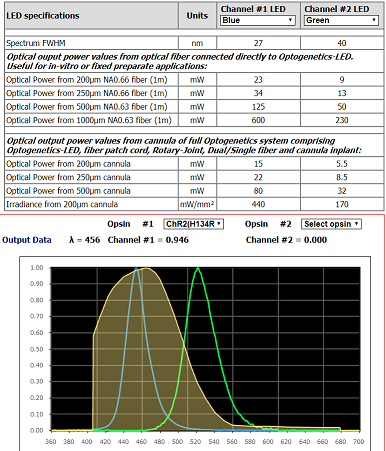Recent Posts
- » Easy Photochemistry Setup with Prizmatix Modular Mic-LEDs and the Cuvette Holder Optiblock
- » Bilateral and Unilateral Fiberoptics for Head-Fixed and Non-Moving Animals
- » Power Versus Intensity when Choosing LED and Light Delivery
- » How to make your own fiberoptic implants for Optogenetics
- » Illumination Inside of an Incubators and CO2 Chambers – Part II
Do LEDs have enough power for In-Vivo Optogenetics?
Posted by Nathaniel Sperka on 30th Mar 2016
Do LEDs have enough power for In-Vivo Optogenetics?
It depends who you ask.
Often, while talking to researchers considering LED for Optogenetics, I hear “People tell me that LEDs just don’t have enough power, especially for inhibition”.
That is a real concern. In fact a competing vendor of LEDs for Optogenetics told me that their light sources do not have enough power, but they sell them anyway.
Consider this statement: “I tested LEDs and they do not have
enough power”.
This may be the truth but possibly not the whole truth. The LEDs may have been
powerful enough; the problem was the fiberoptics. Fiberoptics that work fine
with lasers can be totally inadequate for use with LEDs.
There are two factors to consider when choosing an optical fiber to use with an LED for in-vivo Optogenetics:
- The core diameter of the fiber
- The NA (numerical aperture)
of the fiber.
(For more information see my article “What is Numerical Aperture (NA) and why would a neuroscientist need to know? ”)
When using a laser:
The NA of the fiber does not make much of a difference. Neither does the core
diameter. Using a fiber with a higher NA or larger core diameter will not give
you more power than a low NA fiber. This is because a laser shoots light straight
into the fiber; so the only way to increase the power is by cranking up the
power of the laser.
But when using an LED:
The core diameter and NA of the fiber both make a huge difference. Unlike a
laser, an LED emits light in all directions. The light hitting the entrance of
the fiber hits that little window at many angles. Increasing the core diameter
increases the size of the window and a higher NA increases the percentage of
the light that will travel down the fiber. Using a thin low NA fiber with an
LED is like trying to use a garden sprayer to get water into a drinking straw.
How much does it matter? Does 900% sound like a lot? How about 5,600%? The improvement is geometric and you can calculate it easily. It is the square of the ratio of the diameters and NAs.
For example, let’s compare two fibers. A standard fiber used with lasers has an NA of 0.22 and a Prizmatix high NA fiber has an NA of 0.66. With a laser either fiber will output virtually the same amount of power. But when used with an LED, the high NA fiber will have 9 times more light: (0.66 / 0.22)^2= 900%
When the core diameter is increased, the same idea applies. With lasers, you won’t gain much by using a larger fiber. But with LEDS, a fiber of 400um has 4 times more light than a 200um fiber. An increase from 200um to just 250um will increase the power by (250/200)^2 = 56%. And if you can use a 500um fiber, the increase in power will be (500/200)^2=625%
And if you increase both the NA and core diameter the increase in power will be: 9*6.25=5600%
Let’s translate that into concrete terms:
Say someone tells you that they tested an LED using a fiber with a relatively
high NA of 0.37 (considered a high NA)
and they got 1.5 mW. Increasing to a 0.66 NA fiber, would deliver over 4.5mW. A
250um fiber would deliver >7mW. And with a 500um fiber, the power goes up over
25mW. These numbers are about what a green Prizmatix LED delivers and it is more than enough for Arch or Halorhodopsin.
Update May 2018: Prizmatix's new green 545nm LED can output >13mW of broad spectrum green light in 200um single or bilateral implants after all connections and rotary joints. For spectrum click here.

Update November 2019: Click here to see a new tool on Prizmatix.com shows the latest power level of each wavelength and superimposes the spectrum of the LED over the absorption spectra of the opsin of your choice.
The unique aspect of Prizmatix Optogenetics-LEDs is that they have a very large emitting surface of 2x2 mm. This means that a single chip can output enough power into two fibers for bilateral experiments using our inexpensive rotary joint and a simple Y shaped fiber on the spinning side of the rotary joint.
There are many trade-offs when choosing between an LED or laser. The factors include cost, reliability, stability during pulses, safety, and expenses related to safety compliance. But one thing that does not necessarily have to be sacrificed is power. Generally, you do not lose much by using a high NA compared to a low NA fiber. (For an in depth discussion - see my blog post about tissue heating during Optogenetic experiments .) If your science can tolerate a larger fiber implant there should be no problem getting enough power from an LED.
You can see complete power output information on the datasheets of Prizmatix blue, Lime green and Orange red Optogenetics LED.
For more on LEDs vs Lasers see the Prizmatix paper “ Light Sources for Optogenetic Experiments ”
If you are considering LEDs, please call 248-424-9390 to speak with our consultant about your application. We may be able to refer you to customers who are doing similar experiments using Prizmatix LEDs. You can also arrange a demo of the Prizmatix Optogenetics-LED, with compatible fiber optics for testing at your lab.
Please leave your questions and comments in the comment section below.
